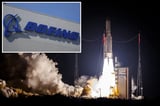Intelsat 33e Satellite Breaks Apart in Orbit, Creating 20+ Debris Pieces
October 21, 2024
Intelsat announced that its Intelsat 33e satellite, built by Boeing, broke apart in geostationary orbit, resulting in at least 20 pieces of debris.
The cause of the breakup remains unconfirmed, but similar incidents have been linked to deliberate destructions, accidental collisions, and increased solar activity.
Holger Krag, head of space safety at the European Space Agency, suggested that internal heating from fuel or batteries, or impacts from space debris, could be potential causes of the explosion.
Typically, satellites are deorbited at the end of their operational life, making the explosion during normal operations an unusual occurrence.
The explosion poses risks as the debris can damage other satellites or spacecraft, raising concerns about the proliferation of space debris.
Intelsat is collaborating with Boeing to address the situation, although recovery of the satellite is considered unlikely.
Intelsat representatives are maintaining direct communication with all affected customers to provide updates on the situation.
Recent months have seen an increase in uncontrolled breakups of satellites, further complicating the challenge of tracking space debris.
Intelsat is in contact with affected customers and is assessing its fleet capacity to mitigate service interruptions caused by the incident.
This incident adds to Boeing's challenges, which include ongoing issues with its Starliner mission and legal troubles related to the 737 Max crashes.
As space activities increase, there is an urgent need for improved monitoring and tracking technologies to manage orbital debris effectively.
Responsibility for space debris cleanup typically falls on the country that launched the object, but accountability is often lacking.
Summary based on 19 sources
Get a daily email with more Tech stories
Sources

BBC News • Oct 23, 2024
Boeing-made communications satellite breaks up in space
The Verge • Oct 22, 2024
A satellite made by Boeing just fell apart in space
The Telegraph • Oct 22, 2024
Boeing-made satellite breaks up in space
New York Post • Oct 23, 2024
Boeing-made satellite explodes to bits in space after experiencing an 'anomaly': 'Total loss'